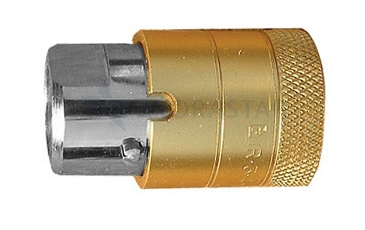Every hydraulic hose relies on a coupling to connect it to other hydraulic machinery. A coupling is any crafted piece of material that provides a secure and tight connection from one hydraulic component to another. Couplings can also be referred to as connectors. However, not all hydraulic couplings are the same. What type of coupling you’ll use depends on the connection size, pressure intensity, heat generation, and intended use of your hydraulics.
Here’s our quick guide to the three major groups of hydraulic couplings.
1) Thread Interface
Thread interface couplings are fully metallic and contain two male and female connectors. These opposing connectors are usually installed as adaptors and then fitted together with a wrench. The tapered bridge contained within creates a tight, immovable lock through which hydraulic fluid can flow.
Threaded connectors are recommended for hydraulic machines requiring tight seals that will stay in place. The high level of security that threaded interface couplings offer means that they’re often found in fuel transfer. Hydraulic systems can similarly benefit from such stringent levels of fluid containment, particularly in permanent systems installed in harsh environments outdoors.
2) O-Ring
O-Ring adaptors are used to create firm seals on high-pressure hydraulic equipment. They’re excellent for containing high-pressure, high-temperature fluid being transferred between pipelines, pumps, and hydraulic components.
O-Ring couplings are made up of an internal rubber guard and a threaded metal outer casing. As the casing is tightened, the O-Ring is flattened and creates a vacuum seal that stops fluid from leaking out or dissipating. They can be made to be either permanent (wrench sealed) or detachable.
3) Mated Angle
Similar to threaded connectors, mated angle couplings use two interlocking male and female sides to form a tight bridge for hydraulic fluid. The mated angle thread slots into place to form a seal. The connector is designed for low-pressure machinery that requires easy modification or has parts that need semi-frequent replacement.
The relative ease with which the mated angle can be detached and reconfigured makes it an attractive choice for low-pressure, low-power hydraulic systems intended for light work, such as actuating pistons. Outside of hydraulics, they’re commonly found in refrigeration lines and water transfer systems. The trade-off for such flexibility is that mated angle connectors typically offer lower heat, leak, and pressure resistance than other couplings.
Find Out More
For advice selecting the right hydraulic coupling for your system, please contact our team by phone on 01353 721704, or by email at info@hydra-star.co.uk.



